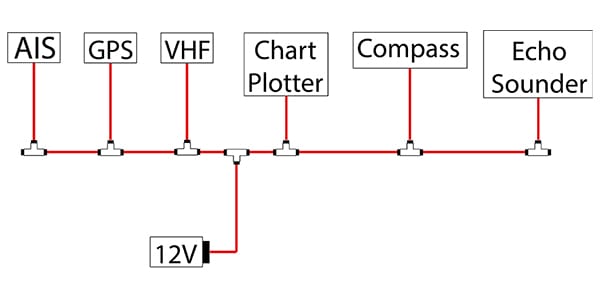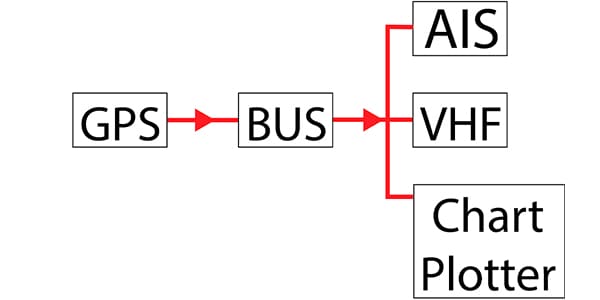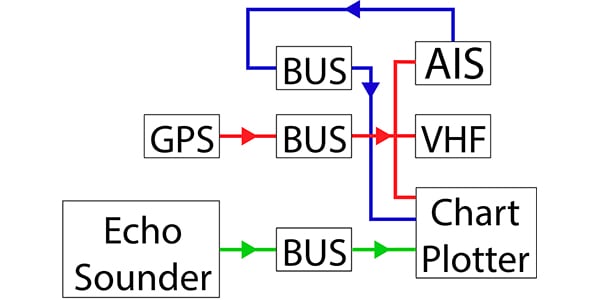NMEA 0183 vs NMEA 2000
Electonic engineers are very familiar with the details and differences between NMEA 0183 and NMEA 2000, but I am a navigator, not an electronics specialist. It has taken me a long time to research the differences, so I thought I would write this article to help out fellow navigators who are also struggling.
NMEA 2000 allows all your marine electronic equipment to be connected to a single backbone, with data flowing in every direction. NMEA 0183 requires a new network for each data source because each bus can only have a single “talker”.
What are NMEA 0183 and NMEA 2000 used for?
NMEA 0183 and NMEA 2000 are different standards that are used to inter-connect marine electronic equipment on vessels. You can think of them as the network that transfers data between equipment.
The National Marine Electronics Association (NMEA) is the organisation that has developed the standards and pushed for its implementation. Manufacturers, dealers and other parties are members of the organisation, all committed to implementing common standards across inter-connected marine electronic equipment.
Marine equipment needs to be interconnected to transfer data between systems. For example, older systems needed to send positional data from the LORAN to the autopilot. Others need to send positional data from the GPS to the VHF, or from the echo sounder to the chart plotter.
Rather than having each manufacturer come up with their own methods of interconnecting marine electronic equipment, NMEA aims to standardise the approach.
Originally it was NMEA 0180 and NMEA 0182, which primarily dealt with the transfer of data between the LORAN and the autopilot. Source: https://nmea.gr/2019/10/20/nmea-faq/
As networking technology advanced, NMEA 0183 became the standard. NMEA 0183 allows one “talker” to communicate with many “listeners”. For example, with NMEA 0183 the GPS can send positional data to the VHF and the chart plotter.
In time, NMEA 2000 was developed to replace NMEA 0183. The difference with NMEA 2000 is that you can have multiple “talkers” and multiple “listeners”. Data flows in all directions. With NMEA 2000, you can have a single network that you can connect each device to. Each device then just accesses whatever data it needs.
How does NMEA 2000 work?
NMEA 2000 is the modern standard for inter-connecting marine electronic equipment.
The concept is that there is a backbone of the network, and every piece of marine electronic equipment is connected to the backbone.

The backbone of the network is formed by connecting a series of T-junctions together. Each piece of equipment on the network is then connected to a T-junction. You can then add additional connections for things like the 12V network power supply, or even an interface to connect the network to another computer network.
The advantage of the backbone network is that it is almost infinitely extendable. All you need to do is to connect another T-junction and you can extend the network to as much equipment as you want.
The NMEA standard means that each piece of equipment has the same physical connection, and more importantly, means the format of the data used is the same. In our example above, the GPS can feed positional data to the AIS. The AIS can receive positional data, and also send target data on to the chart plotter.
All the equipment on the network is communicating with everything else, using the same data. It does not matter which manufacturer produced each piece of kit. Their individual compliance with the NMEA 2000 standard means that they will all work together.
NMEA 2000 has a higher bandwidth than the early NMEA 0183 standard. The higher bandwidth means more data can be carried within the network.
Although NMEA 2000 has a higher bandwidth than NMEA 0183, it is still not high enough for some applications. For example, it is not high enough to send video data or a RADAR feed. For this level of data transfer, the next generation will be needed. It is, however, still in development so NMEA 2000 is the best option currently available.
How does NMEA 0183 work?
NMEA 0183 is an older standard than NMEA 2000, although you will still find it on a lot of marine electronic equipment.
The way NMEA 0183 works is that you build up networks using a data bus. Each data bus can have a single “talker”, and multiple “listeners”.

In the above diagram, you can see how the network works when there is a single data feed. For example, the GPS feeding positional data to the AIS, VHF and the chart plotter. Once you start to add in more equipment, however, the limitation of a single “talker” and multiple “listeners” becomes apparent.

In the image above you can see that connecting multiple talkers and listeners begins to get more complex. The GPS is feeding the AIS, VHF and chart plotter as before. In addition to that, we have added both the echo sounder and the AIS feeding into the chart plotter as well. All the data travels around the system in the correct way, but physically connecting in more devices is a lot more complicated.
Each individual network within the system can have a lower bandwidth. The individual networks only need to cope with a single data feed. When you add in more talkers, you need to add in a new bus to feed that data to all the equipment that needs it. You don’t need to increase the load on any of the existing networks.
Can you use both NMEA 0183 and NMEA 2000 equipment in the same network?
You can use both NMEA 0183 and NMEA 2000 equipment within the same network using converters.
The most common scenario will be that you want to connect an older piece of equipment to a newer NMEA 2000 network. In this situation, you can purchase a converter to complete whichever data conversion you need.
Maybe you want to take the feed from an older GPS and feed it to your other equipment. Your converter will take the “talker” feed from the GPS and send it into your NMEA 2000 network so that everything in the network can become a “listener”.
Alternatively, you may have an older VHF that needs an NMEA 0183 GPS position feed. Again, the converter can be connected to your NMEA 2000 network and be programmed to feed the GPS data flowing within the network down an NMEA 0183 connection to your older VHF.
Converters are readily available, and I have based this section on the iKonvert – NMEA 2000 to NMEA 0183 Converter from Digital Yacht. You can visit their website for more information about this converter: NMEA 2000 to NMEA 0183 Converter.
Which is better: NMEA 0183 or NMEA 2000?
Neither NMEA 0183 nor NMEA 2000 is “better” when it comes to transmitting the relevant data. Both standards allow the relevant data to flow where it is needed. You may determine that one or the other be a better fit for your boat depending on several factors.
NMEA 2000 is better when it comes to the future expansion of your network. You simply need to add in another T-junction and plug in your new piece of equipment. You can still add in more equipment to an NMEA 0183 network, but the wiring can become more complex as we discussed above.
You will probably find that NMEA 2000 is better in terms of compatibility with the most recent equipment, but NMEA 0183 is better with older equipment. As NMEA 2000 is the newer standard, it stands to reason that it will become more prevalent in the future. As progressively fewer boats will use NMEA 0183 networks, the availability of the appropriate equipment will reduce.
In terms of installation into your own boat, NMEA 2000 is undoubtedly better. The plug-and-play nature of the connections means that it is simply a case of plugging a single cable into your network.
With NMEA 0183, connections invariably involve wiring diagrams, adding a level of complexity.
Conversely, when it comes to fault-finding, NMEA 0183 is simpler than NMEA 2000. The fact that each data feed is on its own separate network makes tracing a fault much simpler.
In the future, NMEA is working on developing OneNet. This will be the next generation, with much higher bandwidth than NMEA 2000. One of the goals on OneNet is…
“To deliver interoperability with the established industry standards including NMEA 2000”
https://www.nmea.org/content/STANDARDS/OneNet
From this respect, NMEA 2000 is the better choice because it should still be compatible when the next generation of standards is available.
Overall, given the choice between the two, I would go with NMEA 2000 compatible equipment. I would not, however, be concerned about needing to upgrade any equipment that already runs on NMEA 0183.
Is NMEA 2000 easier to fit in my boat than NMEA 0183?
NMEA 2000 is significantly easier to fit into a boat than NMEA 0183. The reason for this is that it is a simple plug-and-play network that runs across an extendable backbone.
NMEA 0183, on the other hand, requires practically a new network for every new data source.
Even if you just want to make a single connection between a GPS and the VHF, it is still simpler to use NMEA 2000. You just need to plug both units into the backbone and you are good to go.
In the future, if you decide you would like to include a WIFI interface to run a chart plotter on your phone, you simply buy an NMEA 2000 WIFI interface and plug it in.
To connect the same WIFI capability into an NMEA 0183 network, you need to have a listening interface for each data feed that you want to be fed into the WIFI signal.
In addition to the simplification of needing fewer interfaces, the other major advantage of fitting NMEA 2000 equipment is that the connections are all plug-and-play. You plug a wire into the equipment that you want to be connected.
With NMEA 0183, the connections usually need to be soldered in place. The connections are just wires that need to be attached to the correct terminals.
All in all, it is much simpler to work with an NMEA 2000 network than it is to work with NMEA 0183 connections.
How do NMEA 0183 and NMEA 2000 compare when things go wrong?
When it comes to faultfinding, it is easier to do for NMEA 0183 connections. The reason for this is that every data feed is on its own circuit. You can check terminals, and check all the connections individually.
For example, if you find position data is no longer feeding to one of your devices, but it is OK for everything else, you know the problem is with the listening connection between the device and the bus. Should all your devices no longer receive positional data, you know the fault is probably between the GPS and the bus, somewhere on the “talker” line.
On an NMEA 2000 system, it is much harder to find the fault. You will know that there is a fault with the network, but that’s about it. There will be very little indication of exactly which part of the network or which wire has the fault.
In our example above, if something stops receiving positional data it probably means the receiving instrument is faulty. If everything stopped receiving positional data, it would just indicate a fault somewhere within the network. You would have to undertake investigations to narrow it down further.
Theoretically, it is simpler to find faults with NMEA 0183 equipment. At the same time, however, it is easier for faults to creep in due to the nature of all the connections.
Is NMEA 2000 the future?
NMEA 2000 is the current standard for inter-connecting marine electronic equipment on vessels. In the future, the standard will evolve and OneNet will take over.
OneNet operates on similar principles to NMEA 2000, with the main difference being that the connections are via ethernet instead. This gives OneNet significantly higher bandwidth and faster data transfer speeds.
Using ethernet connections allows more devices to be connected and generally permits the networks to become more complex. As we move towards the Internet of Things, this flexibility becomes even more important.
The increase in data transfer speeds and higher bandwidth means that more devices will be able to be connected. Examples include radar feeds and onboard CCTV. The data transfer required is too high for the current NMEA 2000, but easily manageable by ethernet.
Ethernet connections are already common around the world, in use in homes, offices and a whole range of other places. The only thing holding it back from becoming commonplace in marine equipment is the need to have everything standardised across all manufacturers.
This is where NMEA comes in. It is an organisation, comprised of equipment manufacturers, traders and generally everyone interested in the marine electronics industry. Once NMEA finalises and releases OneNet, it will become the new standard. Manufacturers will be able to release the equipment, safe in the knowledge that it will be able to communicate with any other manufacturer’s equipment produced under the same OneNet standard.
